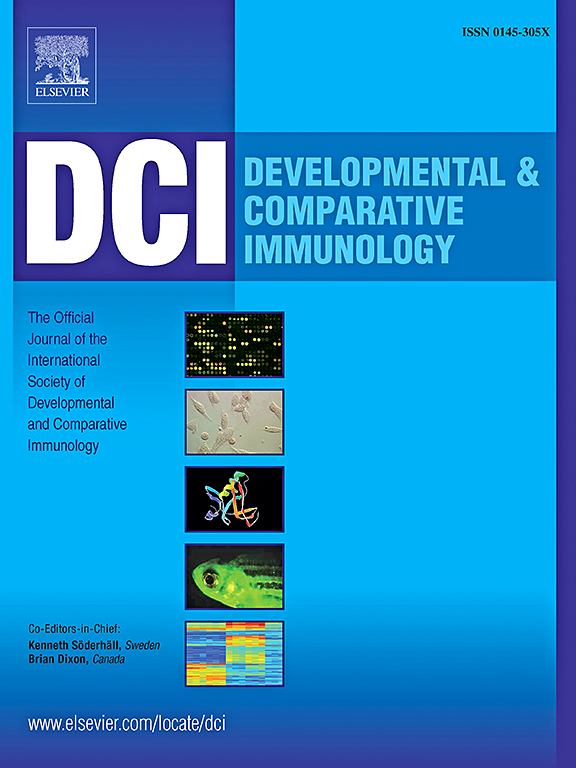HGF-HGFR-STAT信号轴调控牡蛎长牡蛎的血细胞增殖。
IF 2.7
3区 农林科学
Q1 FISHERIES
引用次数: 0
摘要
肝细胞生长因子(hepatocyte growth factor, HGF)是一种多用途生长因子,通过结合肝细胞生长因子受体(hepatocyte growth factor receptor, HGFR)参与多种细胞的分裂和生长。本研究在牡蛎长牡蛎中鉴定出具有保守结构域特征的HGF (cghgf样)和HGFR (CgHGFR)同源物。CgHGF-like和CgHGFR mRNA转录本在所有检测组织中均检测到,且均在血细胞中表达量最高。脾弧菌刺激后,它们在血细胞中的mRNA表达显著升高。免疫荧光分析显示,CgHGF-like和CgHGFR阳性信号分别主要位于血细胞的细胞质和细胞膜中。生物层干涉法测定重组蛋白CgHGF-like与CgHGFR-SEMA体外相互作用。在cghgf - likernai和CgHGFR-RNAi牡蛎中,脾脏v刺激后,EdU阳性信号的血细胞百分比以及CgGATA、CgSCL和CgRUNX mRNA表达水平均显著下调。脾弧菌刺激后,在血细胞细胞核中观察到CgSTAT的阳性信号,而在cghgf - likernai和CgHGFR-RNAi牡蛎中,CgSTAT的核易位受到抑制。这些结果共同提示CgHGF-like可能在免疫应答过程中通过激活CgSTAT与CgHGFR相互作用调节血细胞增殖,提示其在牡蛎C. gigas血细胞增殖中的重要作用。本文章由计算机程序翻译,如有差异,请以英文原文为准。
HGF-HGFR-STAT signaling axis regulates haemocyte proliferation in oyster Crassostrea gigas
As a pleiotropic growth factor, hepatocyte growth factor (HGF) involves in the division and growth of multifarious cells through binding hepatocyte growth factor receptor (HGFR). In the present study, a homologue of HGF (CgHGF-like) and HGFR (CgHGFR) with conserved domain features were identified in oyster Crassostrea gigas. The mRNA transcripts of CgHGF-like and CgHGFR were detected in all tested tissues, and both showed the highest expression level in haemocytes. Their mRNA expression in haemocytes were significantly increased after Vibrio splendidus stimulation. Immunofluorescence assay showed that the positive signals of CgHGF-like and CgHGFR were mainly located in the cytoplasm and membrane of haemocytes, respectively. Recombinant protein CgHGF-like and CgHGFR-SEMA showed in vitro interaction by Bio-layer interferometry assay. In the CgHGF-like-RNAi and CgHGFR-RNAi oysters, the percent of haemocytes with EdU positive signals, as well as the mRNA expression levels of CgGATA, CgSCL and CgRUNX all significantly down-regulated in haemocytes after V. splendidus stimulation. The positive signals of CgSTAT were observed in the haemocyte nucleus after V. splendidus stimulation, however, the nuclear translocation of CgSTAT was suppressed in CgHGF-like-RNAi and CgHGFR-RNAi oysters. These results collectively indicated that CgHGF-like might interact with CgHGFR to regulate haemocyte proliferation by activating CgSTAT during the immune response, suggesting its important roles in haemocyte proliferation of oyster C. gigas.
求助全文
通过发布文献求助,成功后即可免费获取论文全文。
去求助
来源期刊
CiteScore
6.20
自引率
6.90%
发文量
206
审稿时长
49 days
期刊介绍:
Developmental and Comparative Immunology (DCI) is an international journal that publishes articles describing original research in all areas of immunology, including comparative aspects of immunity and the evolution and development of the immune system. Manuscripts describing studies of immune systems in both vertebrates and invertebrates are welcome. All levels of immunological investigations are appropriate: organismal, cellular, biochemical and molecular genetics, extending to such fields as aging of the immune system, interaction between the immune and neuroendocrine system and intestinal immunity.

 求助内容:
求助内容: 应助结果提醒方式:
应助结果提醒方式:


